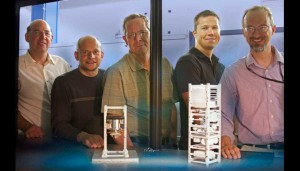
From left to right: Brian Bauman, Vincent Riot, Darrell Carter, Lance Simms and Wim De Vries have developed and tested land-based mini-satellites that eventually will be used in space to help control traffic in space. Photo by Julie Russell/LLNL
Mini-satellites may become “space cops” to help control traffic in space. If so, the idea could help avoid collisions in space of satellites and the creation of even more space debris.
The work is underway by a team of Lawrence Livermore National Laboratory (LLNL) experts. The scientists used a series of six images over a 60-hour period taken from ground-based gear to prove that it is possible to refine the orbit of another satellite in low Earth orbit.
Using the ground-based equipment, the Livermore team refined the orbit of a discarded SL-16 rocket booster of the former Soviet Union’s Zenit family in a 992 km by 1,014 kilometer orbit. It has been up there since late 2001. The Russian Zenit-2 2nd stage is cataloged as NORAD 27006.
Four observations were made of the spent stage within the initial 24 hours, and the LLNL team predicted NORAD’s trajectory to within less than 50 meters over the following 36 hours.
The team believes they will be able to use that information to refine the orbit of a satellite in space and prevent a collision.
False alarms
Today, the Space Surveillance Network must repeatedly observe the set of nearly 20,000 objects it tracks; however, positional uncertainty of an object is about 1 kilometer.
This lack of precision leads to approximately 10,000 false alarms per expected collision. With these large uncertainties and high false alarm rates, satellite operators are rarely motivated to move their assets after a collision warning is issued.
The Livermore scientists are focused in on the Space-Based Telescopes for Actionable Refinement of Ephemeris (STARE) mission.
The tools and analysis used to capture the images of NORAD 27006 and refine its orbit are the same ones that would be used during the STARE mission.
Nano-satellites
STARE would consist of a constellation of nano-satellites in low Earth orbit to refine orbits of satellites and space debris to less than 100 meters.
The STARE mission aims to reduce the 1 kilometer uncertainty down to 100 meters or smaller, which will in turn reduce the number of false alarms by roughly two orders of magnitude.
Lance Simms is lead author of a paper on STARE that will appear in an upcoming edition of the Journal of Small Satellites.
STARE is an ongoing LLNL project led by Wim de Vries, with Vincent Riot as lead engineer.
Other Livermore researchers include Don Phillon, Brian Bauman and Darrell Carter. The work is funded by the Laboratory Directed Research and Development (LDRD) program.
By Leonard David
